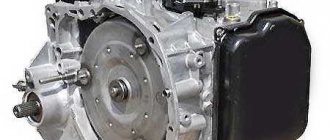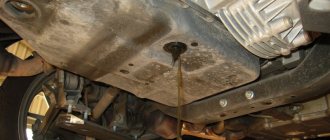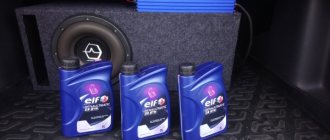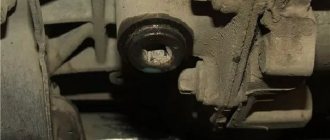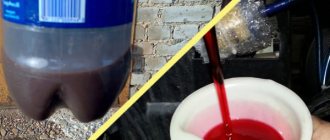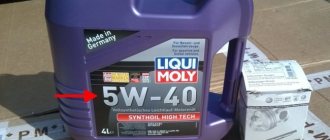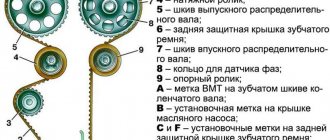Features of changing oil in automatic transmission
In automatic transmissions, the oil becomes very hot when driving.
Therefore, the transmission is additionally equipped with a cooling radiator. Using hoses, the machine is connected to the radiator. The oil constantly circulates, cooling in the radiator and taking heat from the gearbox. The automatic transmission oil must be changed every 50-60 thousand kilometers. This is due to the fact that over time the oil loses some important properties. In addition, during operation, small metal particles appear in it, leading to increased wear of automatic transmission parts.
You only need to fill in with high-quality gear oil, which is recommended by the car manufacturer. In this case, it is advisable to clean the automatic transmission tray and wash or replace the filter.
Even when removing the automatic transmission pan, not all the oil from the transmission is drained. Some of it remains in the pipes and radiator. This is where the main difficulty lies in changing the oil in a machine with your own hands.
Manufacturers' recommendations
Many companies that produce automatic transmissions do not recommend changing the lubricant. Manufacturers argue that this is due to unnecessary costs. Since the transmission fluid filled in at the factory, according to manufacturers, can not be changed until the service life of the automatic transmission expires. For example, like on a Mercedes Benz with a five-speed automatic transmission. Other companies write that the frequency of oil changes depends on the environment in which the car is operated.
Experienced car owners believe that it is worth changing the oil in the automatic transmission after driving sixty thousand kilometers.
The following table from automatic transmission manufacturers shows the frequency of oil changes for different operating environment conditions of the vehicle:
| terms of Use | Mileage | Year of manufacture of the car |
| Difficult, in the north, in countries with hot summers and frosty winters, cities with a damp climate, cold and abrupt starts (territory of the Russian Federation) | 40 000 – 60 000 | Until 2000 |
| Similar to the first (territory of the Russian Federation) | 80 000 | After 2000 |
| Moderate climate, smooth roads, driving in a metropolis, country roads, without cold and sudden starts, careful driving | From 50,000 to 80,000 | Until 2000 |
| Similar to the previous one | 120 000* | After 2000 |
Read
Do-it-yourself oil change in a Nissan Juke automatic transmission
*For example, the same Mercedes Benz manufacturers recommend changing the oil after 125,000 kilometers for vehicles manufactured by the company after 2000.
How does oil work in an automatic transmission?
First, let’s remember the principle of operation of the “automatic machine” in a car. This device connects the engine and wheels of the car, converting the torque of the power unit into the energy necessary for movement. In an automatic transmission, the engine crankshaft is connected to a torque converter (GDT), the output shaft of which works with the transmission mechanisms. The latter set the wheels of the car in motion.
Transmission oil, ATF (Automatic Transmission Fluid), is required for the following reasons:
- Ensures normal operation of the node. It transmits torque evenly to the transmission. Thanks to him, the car moves without jerking and smoothly. ATF acts as a kind of clutch pedal in an automatic transmission. The oil uses its body to activate the torque converter parts.
- Actuating mechanism. Having received a command from the ECU (electronic control unit), ATF exerts pressure on certain channels in the device (hydraulic plate), thereby changing gears.
- Removes heat. As a result of the operation of the mechanisms, the metal heats up. Transmission fluid (oil) removes heat into the crankcase, thereby stabilizing the operation of the device.
- Lubrication function. The metal parts of the gearbox are in constant motion, interacting with other components of the unit. They require constant lubrication. This increases their service life, reduces wear, and improves adhesive properties. ATF acts as a lubricant.
- Removal of waste product. When the mechanism operates, metal debris inevitably forms: dust, burrs, shavings, etc. Oil, with the help of additives added to it, helps the device get rid of unnecessary accumulation, facilitating the operation of the mechanisms.
The purpose of the transmission fluid may vary depending on the type of gearbox installed. In a robotic box, for example Getrag 6DCT250, it is necessary for cooling and lubrication of the gearbox. The remaining components of the device are cooled by air.
Why does ATF lose its properties?
No matter how much we would like, any lubricant partially or completely loses its performance characteristics over time. This happens, to a greater extent, due to the fact that the transmission is operated under rather difficult conditions in which the fluid is exposed to high temperatures . These conditions include operating a vehicle in urban conditions, when the automatic transmission operates for a long time under heavy load .
Another factor influencing changes in ATP quality is the gradual contamination of the radiator, which is designed to cool the transmission fluid.
Also, changes in the operating qualities of the oil are affected by wear particles from the torque converter and friction plates, which become more and more numerous over time. All this speaks in favor of the fact that the car owner is required to check not only the oil level as often as possible . Quality means its color and smell, changes in which will indicate the need for partial or complete replacement of the working fluid .
As they say in any specialized literature, the frequency of oil changes in an automatic transmission should be in the range from 60 to 80 thousand kilometers, and even less when operating the car in difficult conditions.
If these deadlines are seriously violated, you can get the following result:
- malfunctions will appear in the operation of the automatic transmission , expressed in incorrect or untimely gear shifting;
- operation of the automatic transmission will be accompanied by unpleasant jerks and jolts >;
- During operation of the box, extraneous noise >;
- As a result, untimely fluid replacement can result in expensive repairs of the unit itself.
How to replace a filter in an automatic transmission
The procedure for replacing a filter in an automatic transmission is carried out together with the procedure for partially or completely changing the lubricant. The process consists of the following steps:
- Heat the lubricant in the machine. This is done by driving if the car was previously parked. Or start the engine and, for five minutes, press the brake pedal and operate the gear shift control lever.
- Drive onto a pit or overpass.
- Take a measuring container and place it under the drain hole.
- Unscrew the drain plug. Do it carefully. The oil may be hot.
- Drain off all grease.
- Unscrew the automatic transmission pan bolts.
- Remove it by pouring the remaining liquid into a container. Experts advise wearing special gloves to avoid burning your hands.
- Unscrew the three bolts that hold the filter. Carefully remove it.
- Remove it and replace with a new one. Use only the original one.
Attention! External cleaning filter devices are much easier to handle. But they all require draining the oil, since without this, the pressure inside will cause the lubricant to shoot out and spray the car owner and the car’s equipment nearby. This must not be allowed!
What is an oil change?
Complete or partial renewal of transmission fluid in the box. Changing the oil in the machine can be done without disassembling the housing, or with removing the pan and changing the filter.
There is no universal method for changing oil correctly. Each automatic transmission has design features. Some boxes have drain and fill holes; in most models, the transmission is filled through the level dipstick channel.
Regardless of the design, the procedure for changing automatic transmission oil should ensure maximum replacement of the old fluid with a new one, and cleaning of the pan from debris and wear products:
- draining waste through a plug in the crankcase, or pumping liquid out of the dipstick hole;
- dismantling the pan, cleaning cavities, replacing the filter;
- filling in new oil.
Partial oil change - pros and cons
If you do not have the technical ability to completely update the ATF, a partial oil change in the automatic transmission is performed.
Important! This method is not suitable for scheduled maintenance, or for transmission malfunctions caused by problematic transmission fluid.
How to change the oil in an automatic transmission in order to “refresh” the composition:
- The first rule is that the automatic transmission oil is changed in strict accordance with the vehicle’s operating manual: in terms of fluid compliance. No other type of ATF can be added;
- you can change the oil in an automatic transmission in several stages, each time the percentage of renewal increases;
- Of course, complete displacement of waste will not happen, but it will make your box easier to work with.
It is better to properly prepare for a technical inspection with neo-parts.ru, since timely replacement of the necessary parts will keep the car in good condition for a very long time. Taking good care of your car makes you calmer and the ride more comfortable.
Sequencing:
We recommend: Permissible tread height for a new summer tire
The warmed-up car is installed on the inspection hole.
- The maximum possible amount of waste is drained through the drain plug (or dipstick hole), and the volume is measured.
- The same amount of fresh transmission fluid is poured.
- The procedure is repeated after 300-500 km. (3-5 cycles)
A better procedure is to remove the pan, wash or replace the oil filter. In this case, the update percentage increases significantly. A definite plus: it saves time and money (on visiting the service). The disadvantages include excessive consumption of ATF, and the inability to completely update the composition of the fluid.
When do you need to change the oil in an automatic transmission?
All manufacturers regulate the period for replacing ATF. It is not the same for cars of different brands. The service range, based on the mileage traveled, is from 50 to 120 thousand km. The same BMW AG, which recently advocated for the eternity of its technical fluid, recommends filling in new oil after 50 thousand kilometers or 3 years of operation of the car.
An oil change for a car with normal operation is carried out when the vehicle reaches 60 thousand kilometers or two years of use.
Such an operation should be carried out not only in accordance with the manufacturers’ recommendations, but even earlier, as the ATP’s working qualities expire.
In areas with high humidity and extreme temperatures, such automatic transmission maintenance should be carried out every 30 thousand km or once a year. It is also necessary to replace the transmission fluid ahead of schedule for cars that are used daily under heavy load.
The operating conditions of the machine should be taken into account:
- climate;
- intensity;
- driving style.
I would like to particularly focus on the last point. Some vehicle owners themselves are to blame for the fact that transmission fluid is produced prematurely. This is facilitated by an aggressive or sporty driving style:
- constant alternation of high-speed acceleration with sharp braking;
- kick-down reception (when starting to move, the gas pedal is all the way to the stop at a traffic light);
- taking sharp turns at high speed.
The listed actions force the mechanisms to work under extreme load. Accordingly, the temperature in the assembly increases and the parts heat up. Under such conditions, the oil quickly loses its service life and viscosity and needs to be changed.
Why is a complete replacement of the transmission mixture necessary?
In a box, the automatic transmission mixture performs the following functions:
- lubricates the components and mechanisms of the box;
- promotes the removal of dirt and small particles;
- is responsible for cooling the unit.
Adding oil to the automatic transmission
When adding lubricant, you do not remove the formed sediment from the box: chips, particles of contaminants. When the transmission fluid is completely changed, these harmful impurities are completely removed from the unit. Please note: for most foreign models, the normal service life is 5-7 years with an annual mileage of 35 thousand kilometers. Then the car is disposed of; in this situation, the automatic transmission oil can be changed once every two years. For our country, these cars are usually called “almost new”; during their further operation, it is worth giving preference to more frequent changes of lubricant - approximately once every 50 thousand kilometers, or change the fluid every 25 thousand kilometers traveled by the car under difficult operating conditions .
The need to change the transmission mixture is indicated by: blackening of the fluid, the presence of an unpleasant burnt odor, and the presence of small particles in its composition. To check the condition of the transmission oil, drop a drop of lubricant from the dipstick onto a napkin. The presence of one of these signs indicates the need to completely replace the consumable.
Watch a video about the timing of changing the lubricant in an automatic transmission:
How to find out what kind of oil was poured into the automatic transmission?
It seems like a simple question, but it can’t always be answered right away. The service book, which indicates the type of product, may be lost, and determining the color of the liquid on the dipstick is problematic. In such cases, you can use the following options:
- in some cases, information is indicated by the manufacturer under the hood on a nameplate;
- call the official representative, dealer;
- find out information on the Internet site.
As a hint, we note the ATF markings used by well-known brands:
- Volkswagen Group - G-052-055, ZF, in extreme cases - ESSO;
- Toyota – ATF Toyota Tire-T;
- BMW – ZF;
- Nissan – Nissan Matic;
- Mercedes – ATF Mercedes.
Original oils are of high quality, but are expensive. In order to save money, we can recommend using a similar product from other manufacturers. To do this, you need to find out the technical parameters: tolerances, viscosity of the original.
However, in this case, the danger of purchasing counterfeit goods, of which there are more than enough on the market, increases significantly. The use of a fluid with unknown characteristics can lead to automatic transmission failure.
How to check the transmission oil level
Gearbox designs vary. Some have a dipstick with marks to check the level, others have an oil drain hole on the bottom. ATF needs to be checked after it has been heated to a certain temperature in the automatic transmission. The expansion of transmission fluid is affected by the amount of additives, so the readings will differ, even with a temperature difference of 5 degrees. Another important condition: the engine must be idling so that the system is under pressure.
In the gearbox with dipstick
ATF should warm up to operating 80 - 90℃. To achieve this indicator, the car must travel 15 km at a speed of 40 km/h.
The following is the algorithm:
- Place the car on a level area, do not turn off the engine.
- Install the handbrake.
- Set the automatic transmission selector to “P”.
- Take out the dipstick and wipe it dry with a napkin.
- Insert the dipstick into the tube until it stops, wait 5 seconds, remove it and look at the mark.
- The correct level is between the “Hot” notches.
- A red or light yellow sample indicates good condition.
- When checking the consistency, the liquid should be immediately absorbed into the napkin.
In the gearbox without a dipstick
Bring the car onto a car lift or pit:
- Start the engine, set the selector to “P”.
- Warm up the box. Monitor the temperature via a scanner.
- Remove protection. Place a basin for drainage and unscrew the plug.
- ATF should drop in. If this does not happen, there may be two reasons: not enough fluid or low temperature.
- If there is not enough ATF, you need to tighten the plug and turn off the engine. Add liquid and go through the testing algorithm again.
- When the plug is finally tightened, a new washer must be installed. Turn off the engine. Pour ATF back in.
Methods for changing automatic transmission oil yourself
Currently, both partial and complete oil changes in automatic transmissions are used. It is worth saying that the second option involves the use of additional equipment, which is only available at the service station. Let's consider all the methods to change the oil.
Replacement at a service station
procedure for changing the oil at a car service station looks something like this:
- the pipes through which the machine is connected to the radiator are disconnected;
- The oil change machine tubes are being installed;
- Next, you should start the engine and turn on the device;
- The old oil is drained and gradually replaced with new oil.
Thanks to the transparent technological window, you can easily determine the amount of new oil being poured into the automatic transmission.
Having studied the general technology, you will be able to change the oil fluid in your favorite car yourself.
Partial transmission oil change
The first option, recommended for regular maintenance, is called a partial replacement. The essence of this replacement is as follows: you need to drain the oil from the automatic transmission through the drain plug; if there is no such plug, then you need to remove the transmission pan. It is important to understand that all the oil from the automatic transmission is not drained; about half of the oil remains. Old oil remains in the automatic transmission mechanism itself, especially in the torque converter donut, valve body channels and solenoids. Therefore, if you simply drain the oil, only half will drain, which is why this method is called a partial gear oil change.
It turns out to be a partial oil change, it is only half renewed. In general, a partial oil change is simple: lift the car on a lift, unscrew the drain plug or remove the entire pan, and drain some of the old oil into a special container.
It is advisable to clean the walls of the pan from contaminants; for this there are many special cleaning liquids, for example, the Liqui Moly Schnell Reiniger cleaner has proven itself well.
Particularly advanced mechanics measure the exact amount of drained oil, and then fill in the same amount of new oil, this allows you to get rid of setting the oil level with a dipstick.
If you remove the pan, then on almost all automatic transmissions it becomes possible to replace the oil filter. After the oil has been drained and the filter replaced, you need to put the cleaned pan back in place, to do this you need to use a new gasket or sealant. In most cases, the automatic transmission filter kit includes a gasket. As for fresh oil, it must be poured in small portions through the dipstick hole. Of course, you can suck out the old oil from the same dipstick hole, but for this you need to use a special technique.
It is very important that the oil level in the automatic transmission is set correctly. It is advisable to first take measurements while the gearbox is cold, and then, after the gearbox has warmed up, you should also measure the oil level.
Advantages of partial oil change in automatic transmission
No special equipment required. The procedure for replacing the fluid in an automatic transmission can be performed independently, which makes it possible to evaluate the operation of the automatic transmission based on the ATF condition. Small one-time costs.
Disadvantages of partial oil changes
- The transmission fluid is changed in batches: you will have to allocate time for maintenance.
- The final volume poured into the automatic transmission during a partial oil change is greater than the capacity of the box, which leads to increased costs.
- Dirty and clean liquids are mixed in the box.
Price range
The cost of changing automatic transmission oil consists of the price of materials and labor. When purchasing 1 liter of ATF for 800 rubles. — 10 liters will cost 8,000 rubles. Master services - 1000 rub. The total amount for a full cycle is 10,000 rubles. excluding filter replacement and pan washing.
Complete oil change in automatic transmission
This replacement option is more complex; in this case, all the oil in the gearbox is completely replaced; no old oil remains in all parts of the gearbox. A complete oil change in an automatic transmission should be done less often than a partial one. Full-flow oil changes are usually carried out in the following situations:
- after purchasing a used car;
- after 100,000 km. mileage;
- if the car very often drives at high speeds and the engine overheats;
- If problems arise during gear shifting, there is a problem with the solenoid unit.
When doing a complete oil change in an automatic transmission, you can also wash all components with special flushing agents, which not only remove contaminants, but can also restore the functionality of the torque converter locking and solenoid block.
A full-flow oil change in an automatic transmission is quite long - it takes about 1 hour, and costs money if you order this service at a service station. In order to completely drain the old oil, you need to pump fresh oil into the box, which will displace the old oil.
Also, additional oil will be required when replacing the automatic transmission filter. To fully carry out a full-flow oil change, you will need special equipment that will accurately calculate the amount of fresh oil required, as well as calculate the amount of old oil drained.
When performing a complete oil change in an automatic transmission, it is advisable to use a special product - Liqui Moly Automatik Getriebeoil Reiniger, which is designed for flushing automatic transmissions; it thoroughly cleans the valves and channels of the box, and as a result, improves the performance of the automatic transmission.
The process of completely changing the automatic transmission oil begins by checking the oil level using a dipstick; it is also advisable to carry out simple diagnostics.
After this, it is necessary to connect the flushing unit to the hydraulic system of the automatic transmission. The easiest way to connect is through the hoses of the box cooling system. In many cars you can connect using the provided clamps. It is very important to find a radiator that cools the automatic transmission, which in most cases is located inside the main radiator of the engine cooling system. If you provide access to the fittings, you can disconnect the supply tubes and connect them to the flushing unit.
After the new system has become sealed, it is time to start the engine. The flushing unit itself will set the fluid pressure and the direction of oil movement in the system. If there is insufficient pressure in the box, and this should not be the case, then the installation will record a fault in the box, and it will be impossible to change the oil.
It is also important to know that some car models have systems with built-in thermostats, so in such boxes, if there is no pressure in the radiator circuit, then this is normal. It is enough to wait until the engine warms up; pressure will appear after fluid circulation is restored. To change the oil in such a situation, you need to pin the thermostat, this is provided by the developers.
After the installation has been connected, it is time to fill in the Liqui Moly Automatik Getriebeoil Reiniger flushing fluid, which will remove all possible contamination of the gearbox and torque converter, and it will also restore the operation of the valve body and valves (solenoids).
The flushing liquid must be poured into heated oil, because at increased temperatures the detergent additives are more active. After the flush has been filled in, you need to put the box in neutral and park mode for 6 minutes; in these modes, the box valves are cleaned best. Next, within 5 minutes it is necessary to switch all modes of the box so that the flushing liquid circulates through all channels. To prevent the car from driving away, it must be kept on the handbrake.
It is important to know that all flushing is done with the engine idling, that is, you cannot accelerate by increasing engine speed, because this will damage the gearbox.
After approximately 10 minutes of flushing, the unit must be switched to oil change mode. The unit drains the old oil and fluid into a separate canister, and then pours fresh oil into the automatic transmission. Next, it is important to track by color when it is time to stop the operation of the installation: if the color of the incoming and outgoing liquid is the same, that is, all the old oil has been drained, and fresh oil is now circulating in the system.
After this, we can assume that the oil change was successful, but in order to get the most beneficial effect from the oil change, you need to change the oil filter. To change it, you need to do the same as during a partial replacement - remove the pan, clean it and change the filter, then install the gasket and add more oil, which is usually lost when removing the pan. Then you can safely disconnect the installation, return all connections to the initial position, restart the engine, check the oil level with a dipstick, and if the level is normal, then you can consider the complete oil change in the automatic transmission complete.
In general, if everything is done correctly, a full-flow oil change will take about 1 hour of work. A full-flow oil change implies additional costs for oil, which will require twice the volume of gearbox oil to flush the system. But these costs are nothing when compared with the possible costs of repairing an automatic transmission.
Advantages of a complete automatic transmission oil change
- You can completely change the automatic transmission oil yourself in one go.
- The unit is fully flushed.
- The automatic transmission runs on pure ATF, the car becomes more energetic.
Price issue
How much it costs to change the oil in an automatic transmission depends on the design, degree of contamination, and complexity of the procedure. Thus, a complete oil change in an automatic transmission at a service station with flushing will cost from 3,000 rubles for the work, and taking into account the disassembly of the radiator - from 5,000 rubles.
If you decide to change the fluid yourself, then the price will include materials and tools: 20 liters of ATF - 16,000 rubles, oil filter - 2,000 rubles, consumables, a set of keys.
Technology for performing work when changing automatic transmission oil yourself
For those who want to save money, there is an option to replace the transmission fluid yourself. If you follow the technology, the work will not cause big problems.
The following nuance must be taken into account. On different brands, the filler necks and drain holes are located in different places. For those who are going to carry out such an operation for the first time, you can go to the Internet and type in the search: how to change the oil in an automatic transmission. There will be a sufficient number of answers for any brand.
Compressor application
With the help of this unit and a simple device, you can make an independent automatic transmission oil change faster and more efficiently.
To do this, you will need a small compressor (you can use a car compressor), a ten-liter plastic canister and rubber hoses.
Drill two holes of the appropriate diameter in the upper part of the prepared canister into which two hoses will be secured. One is designed to fill the canister with air using a compressor, and the other is for releasing new liquid. By the way, the transmission fluid outlet hose should be lowered almost to the very bottom of the canister.
As you can see, the device is quite simple, but quite effective. Using a compressor, a certain pressure , under the influence of which fresh liquid will begin to flow into the box, displacing the old lubricant.
Remember that the supply must be connected to one radiator pipe. The second pipe will drain, so you should connect it to a hose placed in a container prepared for this purpose.
This procedure should be carried out until clean , clear liquid appears from the drain hose. After this, the process can be considered completed .
Using a plastic bag
For these purposes, you will need a plastic container for new fluid, hoses and a plastic bag .
One hose will need to be installed closer to the bottom of the prepared container. Through it, oil will be supplied to the gearbox. In the upper part of the container (in our case it can be a plastic canister), you need to place another hose, at the end of which a plastic bag . To prevent a rupture, use a bag made of durable polyethylene, otherwise an annoying nuisance may occur and the used liquid will mix with the new one. This hose will drain old fluid from the transmission and fill a plastic bag. Increasing in volume, it will squeeze new lubricant out of the canister, which will flow into the box through the second hose. When clean liquid begins to flow into the bag, the replacement process can be considered complete .
How to replace machine lubricant
Replacing the lubricant in the automatic transmission can be complete or partial. The latter is done when the car owner simply needs to add fluid so that the machine can “live” another 20 thousand kilometers until it is completely replaced, without global damage to the mechanical parts.
Step-by-step instructions for partial replacement
In order to partially replace the fluid, it is necessary to prepare the following elements:
- a container with measurements to understand how much was drained;
- new lubricant;
- funnel.
Partial replacement proceeds as follows:
- Drive the car onto the overpass.
- Leave the engine running and drive the gearbox through all speeds while pressing the brake pedal.
- Turn off the motor.
- Remove the fluid drain plug on the transmission pan.
- Place the measuring container and wait until the oil has completely drained into it.
- Screw in the drain plug.
- Using the measurements, determine the amount of leaked oil and, inserting a funnel into the filler hole, add the required amount of new lubricant.
- Turn on the engine.
- Drive the automatic transmission through all gears again so that the two types of fluid mix with each other.
You can determine the fluid level using a dipstick. If there is not enough lubricant, add more.
Complete replacement
A car enthusiast can completely change the oil to a new one at a service station if the car owner is not sure that he can handle it himself. The owner of the car must determine how long it takes to completely change the oil, guided by the diagram described above.
Items that will be needed during a complete oil change in an automatic transmission:
- new ATF;
- measuring container;
- rubber gasket;
- sealant;
- partner;
- new filter.
Read
Complete and partial do-it-yourself oil change in automatic transmission Toyota Corolla E150/E120 body
How the replacement works:
- Drive the car for five kilometers to warm up the machine thoroughly.
- Stand on the overpass.
- Remove the drain plug and place a container under the pan.
- Wait a while until all the oil has drained out.
- Remove the screws from the tray and carefully set it aside. It may contain an additional half liter of dirty oil.
- Clean the pan from soot deposits and metal shavings. Remove the old gasket and install a new one. Wipe the inside of the tray dry with a lint-free cloth.
- Install a new filter.
- Apply silicone to the pan gasket and screw it to the bottom of the car.
- Tighten the plug and pour in new oil. You will need as much of it as was poured into the measuring container.
- Remove one cooling hose, which is located in the direction of travel, and insert it into the prepared five-liter bottle.
- At this time, the partner must put the car on the handbrake and the automatic transmission switch to neutral speed. Start the engine. The old oil, which is pressed through by the newly refilled oil, will be drained into the bottle using a hose. Drain until the oil turns light. This means that something new has happened. This can stop further drainage.
- Add the same amount as drained.
- Re-tighten the car cooling hose.
- Drive the car for five kilometers and check the level. If necessary, top up.
Replacement procedure for different types of automatic transmission
The most difficult ones are 6 and 8-speed automatic transmissions. If some parts of such boxes do not fail under the influence of high temperatures, then they certainly malfunction. Such boxes, as a rule, are distinguished by intelligent electronic control, so in this situation it is preferable to entrust the oil change to experts . 4- and 5-speed automatic transmissions have a simpler technological structure. However, here you should adhere to some rules:
- Do not mix oil of different types, classes or even different manufacturers. If you are not sure of its type, then only a complete oil change in the automatic transmission is carried out;
- use only original operating oils. Modern transmissions operate only on original oil mixtures. Otherwise, there is a risk of parts failure. In particular, electrical regulator solenoids, which control the pressure on the clutches, are particularly sensitive to oil. This significantly affects the useful life of the box.
By performing timely oil changes and following these few simple rules, you will extend the life of your car's automatic transmission. This is the key to long-term, and most importantly safe, operation of the car. For more information about the procedure for changing the oil in an automatic transmission with your own hands, see the following videos . Watch this video on YouTube
Watch this video on YouTube
Which filter is better to choose?
Manufacturers have developed special filters and ATF for different gearboxes. Installing materials that are not similar to the original will lead to failure of the automatic transmission.
Attention! On modern cars, only single-layer or double-layer felt filters are installed.
The following table of some car models and automatic transmission cleaners will help you figure this out.
| Car modification | Filter and its catalog number | ATF |
| Ford Focus, Mazda 3 | Felt, flat design No.JT317KJS | XT10Q LVC |
| Honda Civic | Felt №25430plr03 | Total Quarts 9000 Future NFC 5W30 |
| Suzuki Vitara | Felt with metal mesh No. 113170 | Mobil ATF 3309 |
| Hummer H2 | Flat felt No. 24208576 | Any with Dexron IV specification |
| Infinity F35 | Reusable with metal mesh No.ST462404C000 | ATF Matic J |
| Kia Rio, Ceed | Combined, felt No. 46321 | ATF SP IV |
Read
What is the difference between rights to an automatic and rights to a manual?
The car owner can find which part to install and what oil needs to be poured into the vehicle’s automatic transmission in the operating manual. These instructions usually indicate all the necessary parts for repairing an automatic transmission.
Which oil to choose for automatic transmission
The manufacturer selects ATF based on viscosity, load tolerance, and the number of additives. Therefore, when choosing oil to replace in a machine, you need to adhere to the manufacturer’s recommendations. This will ensure stable operation of the unit.
Original oil
The category of acceptable automatic transmission oil can be found in the car manual and on the label under the hood. The table summarizes popular models.
| Manufacturer | Transmission | Original ATF |
| Kia, Hyundai | A4AF3 | SP-III |
| A6MF, A6LF | SP-IV | |
| VW, Skoda, Audi | 09G/TF60SN | G 052 025 A2 G 055 025 A2 |
| ZF 6HP19/09L | G 055 005 A2 | |
| Mazda, Opel | TF-81SC | T-IV |
| Chevrolet, Opel | GM 6T30, 6T40, 6T45 | DexronVI |
| Peugeot, Citroen, Renault | DP0/AL4, DP2, DP8 | Dexron III |
Analogs
You can change the oil in the automatic transmission with a similar one of suitable viscosity.
| Manufacturer | Transmission | Original ATF |
| Kia, Hyundai | A4AF3 | ZIC SP-III |
| A6MF, A6LF | ZIC SK SP-4 | |
| VW, Skoda, Audi | 09G/TF60SN | Mobil 3309 Esso Type LT 71141 |
| ZF 6HP19/09L | Ravenol 6HP Fluid | |
| Mazda, Opel | TF-81SC | Toyota WS |
| Chevrolet, Opel | GM 6T30, 6T40, 6T45 | Liqui Moly Top Tec 1200 Mobil or Petro-Canada Dexron VI |
| Peugeot, Citroen, Renault | DP0/AL4, DP2, DP8 | Elfmatic D3 SYN |
Types of automatic transmission oil
In service books for cars, manufacturers indicate the types of motor and transmission fluids intended for use in engines of different sizes. This information allows you to select a lubricant according to your vehicle model. But in the service manuals you will not find information regarding the types of consumables. Automatic transmissions can use several types of lubricants - Dexron, Mercon and MV.
In addition to these classes, other specifications can be used for automatic transmissions - MAN, Chrysler, Toyota, etc. Vehicles sold in European countries are equipped with ZF type gearboxes. Lubricants for such units are selected in accordance with General Motors classes. In transmissions equipped with Audi, Mercedes and BMW gearboxes, only synthetic consumables are allowed.
Let's look at each of the main types of oil separately.
Mobil oils for automatic transmissions
Class A
The first class was accepted by General Motors. Type A lubricant designates a type of oil intended for use in automatic transmissions of passenger cars. Consumables that have been researched and tested in laboratory conditions are assigned AQ numbers. They were appointed by agreement with the representative office of General Motors, as well as the Amour Research laboratory. Today this specification is no longer relevant.
Class B
Class Dexron B is considered one of the most common and relevant. This standard is assigned to products intended for use in automatic transmissions of General Motors vehicles. Types 2, 3 and 4 are the latest automatic transmission consumables. Such products are subject to more stringent requirements. Oils of this class must comply with all previous standards, as well as environmental safety requirements.
Products of the Dexron 2 class, Plus Dexron, like Dexron A, were created for use in gearboxes operating under conditions of increased thermal and mechanical loads. Their use is allowed in transmission units of passenger vehicles from any manufacturer. The use of oils is allowed in power steering systems and clutch systems.
Class F
You can find type F products on sale. Such oils are produced by Ford and differ significantly in composition, as well as friction parameters, from Dexron oils. The fundamental difference lies precisely in friction. In Ford oils, the parameter increases as the slip rate decreases, and in General Motors products this value decreases as the slip rate decreases. In accordance with the manufacturer's recommendations, type F products are allowed to be partially replaced with Dexron 2 oils if absolutely necessary.
About types of filters
Transmission fluid, passing through the filter in the automatic transmission, leaves in it all the debris that it brought from the box. Therefore, manufacturers have paid special attention to the filter since the beginning of the production of automatic transmissions.
Attention! The first four-speed transmissions did not require a filter as such. They digested any oil and any dirt. Many car owners did not even know that their automatic transmissions had filters, since the latter were installed quite deeply and were not remembered until the first major overhaul.
The table below provides important information about the types of cleaning devices from the very beginning of the automatic transmission.
| Name of the filter device for automatic transmission | Description: why it was installed, how it was attached, etc. |
| Open metal | It had a simple device and consisted only of a metal mesh. Throughout its life, the automatic transmission was not changed, but only washed. The only exceptions were machines where drivers forgot to change the lubricant. Oil deposits and burnt wear products clogged the mesh to such an extent that it was impossible to rinse. And the clogged filter device became even more clogged with large wear products. As a result, the machine failed. |
| Closed metal | The main difference from the first automatic transmission filters is the closed unit and the ease of replacing the device. Back then, when they were used, gaskets and a large number of screws were not invented by the manufacturers. It was attached to the hydraulic plate using three bolts with a cork cover. Replaced after the second complete change of automatic transmission fluid. |
| With felt membrane | Due to the development of solenoids, valves, and intelligent control of automatic transmissions, manufacturers began to tighten the requirements for oil quality, as it began to play not only a passive role in the form of lubrication, but also an active one - creating pressure. A new generation of filters with a felt membrane has appeared. For example, a filter for an automatic transmission 5HP19 with a single-layer membrane under catalog number 192010. Installed on Mercedes with a 6-speed automatic transmission. The automatic transmission lubricant and filter are changed at the same time. |
| Double-layer with felt membrane | Appeared in the mid-90s. It became pointless to wash these filters. Therefore, they could only be replaced. Their device allows you to flush out the lubricant after installing a new one through the first layer. This ensures a short rinsing path. As the oil becomes clogged, it goes through a long flushing path and is washed through the bottom, second layer of felt membrane. Not only large debris is retained, but also small particles from the emulsion from glue and destroyed rubber pads. As a result, spools and solenoids, and other valves in the hydraulic plate work longer. Replacement should be done every 30, 40 thousand kilometers. |
| Built-in | These devices only appeared in some transmissions. For example, ZF6HP26 with catalog number 181010. Installed only on passenger cars to save space. For high-riding jeeps they were separated. |
| External | Installed on variators. Since in these gearboxes the oil should reduce the slipping of the belt on the metal and reduce metal wear. Therefore, you need to change the filter as often as possible. For example, one of these filters can be seen on the CVT model JF011E under catalog number 316010. |
| External trunk | It is installed additionally on CVTs, where access to conventional filters is complicated. It is installed in the oil cooling system. For example, it is often used for RE5R05A slot machines. This is a fine filter. It intercepts all adhesives and wear dust. As a result, it can work for 3 years without replacement, provided that the seals are not eaten and the box operates normally. It needs to be changed when opening the oil pan. |
Read
Original oil and analogues for Honda automatic transmissions
Read
What to do if the automatic transmission kicks
Addition about weak points of filters
If the automatic transmission filters of the early days of automatic transmissions consisted of a metal mesh, they essentially did not need to be replaced at all. Those with a felt membrane are very capricious and disposable.
The cold season is the most difficult period for such devices. Especially when the lubricant has not been changed for a long time, the clutches are worn out. As a result, the pressure drops and the pump wheel wears out quickly.
The transmission becomes unusable after 1 such winter. Therefore, manufacturers recommend changing the oil and felt membrane cleaner every 40 thousand kilometers.
What drivers need to remember
Due to the fact that manufacturers are only trying to increase their own profits, you should not wait for the availability of repair kits or new gearboxes for a complete change after the “warranty” period has expired. By that time, completely different vehicle models with updated mechanisms will have already been released, often incompatible with the old ones for real reasons, such as technical requirements in the countries of sale, or due to far-fetched reasons, inducing the purchase of a new vehicle.
Wear of an automatic transmission occurs primarily not in hydraulics or mechanics, but in the very material from which it is made - metal fatigue plus sometimes extreme temperature changes lead to the appearance of chips in different quantities. Under no circumstances should waste oil be poured into the ground or water - it is a hazardous substance, so complete disposal will be required. On-board diagnostic systems will allow you to determine the exact malfunction in the gearbox, so there is no need to immediately crawl under the hood to carry out these manipulations.
You should not fall for advertising such as a “lifetime” warranty on components, but change the oil immediately when these signs appear. It is better to make a purchase locally, and purchasing consumables via the Internet can end in failure due to the fact that you can easily receive incompatible liquid or spare parts that do not meet the basic parameters.


